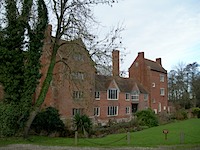A medieval and Elizabethan moated manor house with the best Priest-holes in the country, and fine remains of Elizabethan wall-paintings.
I tend to get excited about a lot of historic houses, but Harvington Hall has a very special place in my heart. It's probably the first historic house I ever visited and during my childhood, I made several tours of the Hall. At one time I thought I could give almost as good a tour as the guides.
Although I haven't lived near Harvington Hall now for many years, it's still the place I'd most like to own if a fairy god-mother waved her magic wand. Now that's not to say it's a fluffy or cosy type of house. Quite the contrary. Something of it's recusant past and the anxiety that must have been felt there during the sixteenth and seventeenth century seems to have seeped into it's walls. Nevertheless, it is a simply wonderful house, full of mystery and confusion. I just love it.
There was a timber framed house on the site back in the fourteenth century - the low range where you enter is the oldest part of the Hall, the section which was once the solar of the first house. But the house you see today was built in the 1580's by Sir Humphrey Pakington, a Catholic landowner in Worcestershire, and a good friend of Thomas Habington of Hindlip Hall, near Worcester, from who's house the senior Jesuit priest in England, Father Henry Garnet, arranged the dispersal through the country of his outlawed priests.
To be a Catholic priest in Elizabethan England was to court death, so Catholic homes built elaborate secret places within their walls in which to hide the priests, should search parties arrive - which they all too often did.
The seven surviving priest-holes at Harvington Hall are in my opinion the best you can see anywhere in England. It's believed that four of them were constructed by Nicholas Owen. My favourite is the one in Dr Dodd's Library. It's hidden behind what would have been a bookcase. It was only discovered in 1897, and inside they found an oak stool. The room itself is around 8' x 3' x 5'.
There's another beauty hidden within the staircase itself. And you can find a fake fireplace - so well concealed, it even has the marks of a fire in the hearth.
While you're looking for hiding places, don't miss the Elizabethan wall-paintings. They were uncovered in 1936 under a coat of whitewash paint. The blood and tears of Christ are poignant.
Nicholas Owen and Father Garnet were amongst the priests discovered at Hindlip in the searches that followed the Gunpowder Plot of 1605. Owen died while being tortured in the Tower of London. Garnet was hanged, drawn and quartered.
Walking round Harvington Hall you really do step back into the past. It's so unspoilt that you can very easily feel what life would have been like for the people who lived there during the turbulent years of English religious history. It's also immensely confusing - try and work out where you are, it's difficult, almost as if the house itself is doing it's best to keep all it's secrets.
The house was practically derelict when the Roman Catholic Diocese of Birmingham bought the Hall in 1923. Since then however, the Hall has been wonderfully restored. Full marks to them and to the people who keep the Hall thriving today. Apparently you can hold your wedding reception there now. Sounds like heaven to me, but I might not have wanted to leave!







